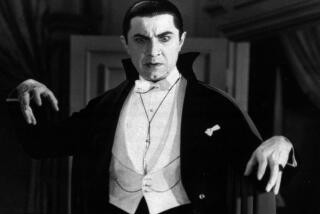Shining a light on metaphorical readings of ‘The Shining’
Since its release in 1980, Stanley Kubrick’s film adaptation of Stephen King’s “The Shining” has firmly embedded itself into the pop consciousness with its shudder-inducing cry of “Here’s Johnny!” and its blood-soaked hallways.
“Room 237,” which opens Friday in Los Angeles, digs into five of the myriad theories of interpretation that have sprung up around what is now a modern horror classic. The proponents of these theories, heard only in voice-over, function as narrators as they rather plausibly lay out “The Shining” as a metaphor for the genocide of Native Americans, for the Holocaust, as an exploration of the mythology of the Minotaur and/or as Kubrick’s secret confession that he was involved in faking the Apollo 11 moon landing.
Then there’s the line of thinking that posits that deeper meanings can be revealed by screening “The Shining” forward and backward, simultaneously and superimposed. (Because who wouldn’t think of that?)
PHOTOS: Haunted houses and deadly dwellings on film
“It may be false advertising to say that ‘Room 237’ is the decoder ring of ‘The Shining,’” said director Rodney Ascher. “It could probably be an expectation of people going into it. But in fact, it’s probably going to leave you with more questions than you begin with.”
“The Shining” is a psychologically rooted horror tale seemingly tailor-made for a sort of obsessive rewatching and reinterpretation. It stars Jack Nicholson and Shelley Duvall as a couple who move with their young son to a secluded mountain resort to act as winter caretakers.
“Room 237,” which is already available on VOD and digital platforms, also points to a larger question: What is it about “The Shining” that inspires this intense level of interest, dedication and interpretation?
“First off, horror movies always make the best metaphors,” said Ascher during a recent interview with producer Tim Kirk. “And ‘The Shining’ is an endlessly watchable movie. There are tons of European art films that were more plainly symbolic, but they’re not necessarily as fun to watch.”
Ascher had previously made a short film called “The S From Hell” in a style similar to “Room 237,” which explored how the 1964 Screen Gems logo was “the scariest corporate symbol in history.”
Made up of footage from “The Shining” and other Kubrick films, imagery from other movies and shots created for the film, “Room 237” itself is a hybrid, part documentary, part essay, a remix with a splash of the horror film. Ascher and Kirk say they never reached out to — and have never heard from — anyone involved with the Kubrick estate. (The poster for “Room 237” contains a comically large disclaimer to that effect.) So while Kubrick’s former assistant Leon Vitali was recently quoted as dismissing the ideas in “Room 237” as “total balderdash,” in many ways such an attitude misses the point.
PHOTOS: Hollywood Backlot moments
“We’re not looking for the truth, per se, as in we don’t want to talk to the set decorator or the screenwriter,” Kirk said. “At this point I have reached a stage where I don’t really care what Kubrick intended.”
“It was the decision to say this is a movie about how the audience puts the pieces back together,” Ascher added. “Once we go to anyone involved in the making of it, it becomes a behind the scenes project. And what seemed most interesting was to keep the focus squarely on this side of the screen.”
Stanley Kubrick’s compact body of work — he only made two more films after “The Shining” — has become the subject of even more intensive study and analysis since his passing in 1999.
“I think ‘The Shining’ is still completely Kubrick’s film. All his films are completely Kubrick’s films,” said Bernardo Rondeau, assistant curator of film at the Los Angeles County Museum of Art, who recently organized a retrospective of Kubrick’s films in conjunction with an exhaustive exhibition of Kubrick’s production materials. Many of Kubrick’s films, including “The Shining,” will be re-running at the museum beginning in late May.
“People are always obsessing about this notion of Kubrick as the mastermind, the person in control of every single detail, with everything coded with some meaning that he only knows,” Rondeau said. “What ‘Room 237’ does is show how we can never really know what Kubrick’s intentions were.”
PHOTOS AND MORE
TIMELINE: Violence in movies
ENVELOPE: The latest awards buzz
PHOTOS: Greatest box office flops
More to Read
Only good movies
Get the Indie Focus newsletter, Mark Olsen's weekly guide to the world of cinema.
You may occasionally receive promotional content from the Los Angeles Times.










